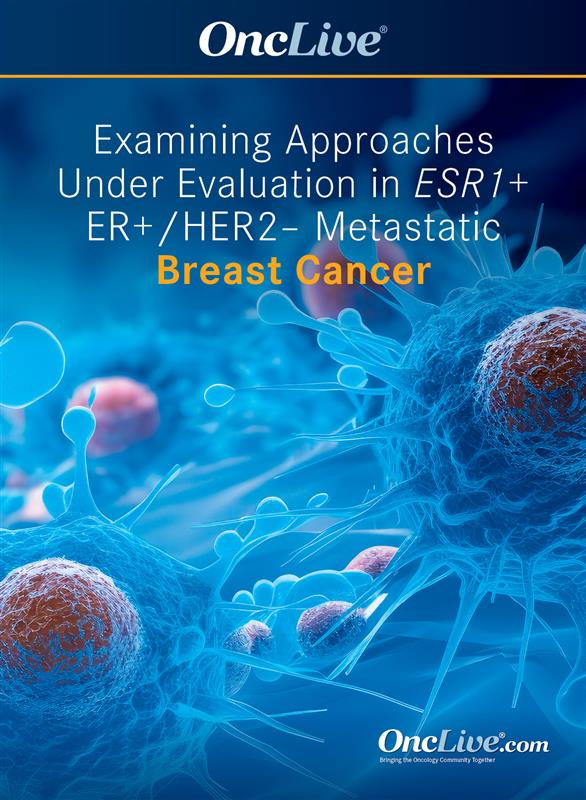Quality of Life, Toxicity Weighed Most by Patients When Choosing Metastatic Breast Cancer Treatment
Quality of life and adverse effects are key components most patients with estrogen receptor–positive, HER2-negative metastatic breast cancer weigh when choosing an anticancer therapy, according to patient-reported results of an ESR1 QUAlity of Life Survey 3 survey.
Sarah L. Sammons, MD

Quality of life (QOL) and adverse effects (AEs) are key components most patients with estrogen receptor (ER)–positive, HER2-negative metastatic breast cancer weigh when choosing an anticancer therapy, according to patient-reported results of an ESR1 QUAlity of Life Survey 3 (EQUALS 3) survey that were presented during the 2023 San Antonio Breast Cancer Symposium.1
Results showed that QOL was reported as poor or very poor in 20% of patients, and 68% of them considered QOL to be an important or very important consideration when choosing treatment based on risks and benefits. Some of the most common AEs that had a negative impact on QOL were sexual dysfunction (45%), joint pain (38%), vaginal atrophy/dryness (36%), fatigue (33%), bone pain (31%), and alopecia (26%).
“Twenty percent of patients reported poor QOL, and two of the top 3 side effects impacting QOL were urogenital in nature; this highlights the need for improved medication and supportive care,” lead study author Sarah L. Sammons, MD, of Dana-Farber Cancer Institute, and coinvestigators, wrote in the poster that was presented at the meeting. “Patients should be educated about the importance of fully reporting treatment side effects on and off clinical trials and the effects of any recommended dosing changes on safety and efficacy.”
In the study presented at the 2023 SABCS, investigators sought to have an improved understanding of reporting accuracy and the impact of treatment-related adverse effects (TRAEs) in patients with ER-positive, HER2-negative metastatic breast cancer.
The online EQUALS 3 survey comprised 55 questions and was emailed to US patients from CURE Media Group and the study authors’ contacts; this was designed to improve minority patients’ participation). The survey was also posted in June 2023 to private social media groups, specifically Facebook and Twitter, for patients with metastatic breast cancer.
Eligible patients had ER-positive, HER2-negative metastatic breast cancer and underwent treatment changes due to disease progression. All participants received a $10 gift card for submitting their responses.
Across the 213 participants, patients were aged younger than 40 years (8.9%), 40 to 49 years (34.3%), 50 to 59 years (33.8%), 60 to 69 years (12.2%), or 70 years and older (10.8%). Most patients were Hispanic/Latino (48.4%) or White (44.2%), and either premenopausal (34.3%), postmenopausal (44.2%), perimenopausal (15.5%), or uncertain (11.7%). More than half of patients lived in an urban setting (51.2%) and 40.8% had an average household income of $50,000 to $75,000. A total 55.4% of patients had received their bachelor’s degree as their highest level of education, and nearly two-thirds had a female as their primary oncologist who worked in an academic hospital (65.3%).
Additionally, 36% of patients were on their second-line treatment vs 51% of those who were on their third. The current treatments they were on for their metastatic breast cancer included endocrine therapy plus or minus targeted therapy (71%), chemotherapy (11%), antibody-drug conjugate (8%), and other (9%).
Further findings showed that 49% of patients reported additional AEs that had a negative impact on their anxiety (49%), such as career (46%), marriage (42%), finances (32%), housework (30%), and relationships (19%). Forty-six percent of patients stated that they regretted taking their cancer therapy due to the related AEs.
The most frequently reported AEs that were extremely or moderately concerning to patients included respiratory symptoms (51%), blood clots in lungs (49%), or heart/brain (47%), cognitive dysfunction (47%), infections (46%), nausea/vomiting (44%), cardiac AEs (44%), diarrhea (42%), gait-instability (41%), fatigue (39%), joint pain (39%), alopecia (33%), and sexual dysfunction (27%).
Forty-nine percent of patients reported that they felt extremely or very comfortable discussing TRAEs with their providers; however, 62% reported that the AEs were minimized in team discussions, the top reasons were fear of being seen as a complainer (70%), having a dose reduction (66%), or their treatment discontinued (65%). Additionally, 47% of patients minimized their TRAEs with their providers for fear of being taken off a clinical trial, and 47% did not report select TRAEs at all. Reasons for nonreporting included being seen as a complainer (63%), having their treatment discontinued (57%), or having less clinical efficacy if their dose is lowered (51%).
“Clinical trials should routinely report the impact of dose intensity on outcomes so that treatment teams can educate patients about treatment side effects and can encourage dose reductions when necessary and safe to improve QOL,” the authors concluded.
Reference
Sammons SL, Meisel JL, Shanahan K, et al. Minimization of treatment toxicity/side effects and their impact on quality of life (QoL) in patients (pts) with ER+/HER2- metastatic breast cancer (mBC). Presented at: 2023 San Antonio Breast Cancer Symposium; December 5-9, 2023; San Antonio, TX. Abstract P03-12-06.




